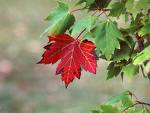 GLEBE TREES AND SHRUBS
GLEBE TREES AND SHRUBS
IDENTIFICATION OF GLEBE TREES AND SHRUBS - by form
1. Trees and shrubs occurring in clumps
2. Observations about tree form and shape
3. Catkins
4. Differentiating the maples
5. Mnemonics
1. Trees and shrubs occurring in clumps
Buckthorn, European
Buckthorn, Glossy
Dogwood, Red osier
Dogwood, Round-leaved
Forsythia
Honeysuckle, Fly
Honeysuckle, Tartarian
Lilac
Maple, Amur
Mock-orange
Nannyberry
Pea tree
Sumac, Staghorn
2. Observations about tree form and shape
hallowe'en = oak
sudden direction changes, short, offering things = apple, fruit
waiter carrying trays on palms of hands = white pine
downcast spruce = Norway spruce
classic elm shape = elm, sometimes maple
bark is messy, shreddy, dark and lighter, in clumps = honeysuckle
green-yellow flowers everywhere in late April = Norway maple
old keys still on tree = Manitoba maple, Amur maple, ash
old leaves still on tree = beech, ironwood, oak
needs a haircut = purpleleaf sandcherry
explosions of pink on many Ottawa trees in May = flowering crabapple
trees recently planted by the city with a protecting circle around the base = Japanese lilac
trees lining the W side of the Bank St Bridge = austrian pine, honeysuckle, amur maple near QE Dr
3a. Trees with dense long pendulous catkins
White birch
European birch
Ironwood - (sometimes short?)
Eastern cottonwood
Hazel
3b. Trees with less dense, usually shorter catkins
Willow
Weeping willow
Red oak
Bur oak
English oak
White oak
Trembling aspen and other poplars
4. Differentiating the maples
Differentiating the maples by leaf: see leaf identification section.
Differentiating the maples by fruit (keys, seeds)
The keys can help differentiate.
Manitoba maple have long hanging sets of keys.
They are very small and a dark red. They appear in May. They often hang on the tree all winter.
If not, their long hair-like strands of stems can be seen in winter. Manitoba maple trees are one
sex or the other only, so keys appear only on the seed-bearing trees.
Sugar maple appear to be big keys, with bulging seed cases, set up in a dense row along a branch.
I saw them first May 16.
Silver maple keys first observed in 2008 on May 18. Tight clusters, not hanging, fairly large
Fallen keys can help differentiate. Where you see lots of them on the street, look around to see what tree they
came from.
Differentiating the tall maples at the start of April, from a distance
(1) Are there very big blocks of flower buds visible from a distance? Silver maple or red maple
Both have red to reddish brown buds. Silver maple have bigger buds.
Red maple buds can look more like rings at the end of the branch.
Sometimes on a cloudy day, Manitoba maple buds can look like red maple flower
buds from a distance. Look for the leaning, scraggly, usually not so tall form of
Manitoba maple. Up close, the buds are very different.
(2) If there are no prominent buds at all, are there prominent single brown buds, especially terminal buds,
visible from a short distance, and angular old fruit stems, about 4-5 to a unit? If so, that is Norway maple or
one of its varieties, Schwedler or Crimson king.
(3) If not, are there only small pointy buds visible from fairly close? That is sugar maple. They can have old fruit
stems that seem a little shorter than those of Norway maple.
5. Mnemonics
Opposite-leaved trees and shrubs: MANH(an)DLE-BBCCET = maple, ash, nannyberry (viburnums), honeysuckle, dogwood, lilac,
elder and elderberry, buckthorn, buttonbush, catalpa, clematis, trumpet-creeper
Note: those which have compound leaves are the vowels, plus T, or TEA
Alternate compound-leaved trees and shrubs: BL(e)MISH: sumac, hickory, locust, pea-tree, mountain ash, butternut
(and black walnut) (The "I" is really a "P")
E-mail error reports.
 GLEBE TREES AND SHRUBS
GLEBE TREES AND SHRUBS GLEBE TREES AND SHRUBS
GLEBE TREES AND SHRUBS